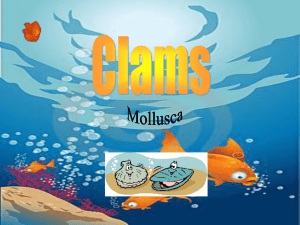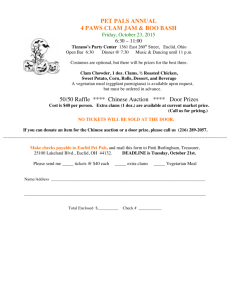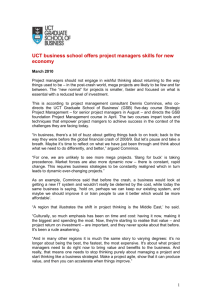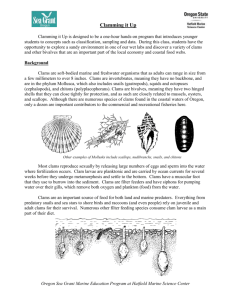LoBue
advertisement
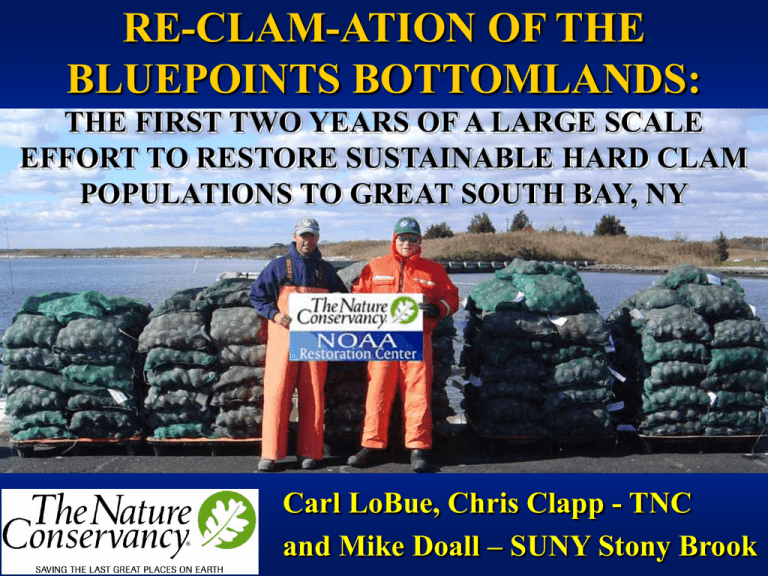
RE-CLAM-ATION OF THE BLUEPOINTS BOTTOMLANDS: THE FIRST TWO YEARS OF A LARGE SCALE EFFORT TO RESTORE SUSTAINABLE HARD CLAM POPULATIONS TO GREAT SOUTH BAY, NY Carl LoBue, Chris Clapp - TNC and Mike Doall – SUNY Stony Brook TNC’s interests in shellfish are based on ecosystem services and their historic dominance at our sites No clams 2 clams 4 clams 8 clams 16 clams Hard clams and bay scallops in Peconics since 2001 Hard clams in Great South Bay since 2004 In 1970s, there were enough hard clams in Great South Bay to filter the entire volume of the bay in ~2.5 days, and over 50% of US clams came from GSB Great South Bay clam harvesting circa 1970 Today harvest is down by over 98% and it takes clams ~36 days to filter the bay Annual Hard Clam Harvest from Great South Bay Brown tide 1985 Data from NYS DEC 700,000 Brookhaven 600,000 500,000 Babylon 400,000 300,000 200,000 100,000 Year 2002 2000 1998 1996 1994 1992 1990 1988 1986 1984 1982 1980 1978 1976 1974 1972 0 1970 # of Bushels Other shellfish have not replaced clams Islip Apparent shift in the composition of dominant algal species Much of New York’s bay bottom was deeded prior to statehood These 13,000 acres in central GSB, have been in private ownership for over 300 years •The lands were used for private shellfishing and aquaculture, including mechanical harvest (since 1912 by the Bluepoints Co.) •Bluepoints Co. divested from GSB in 2003 •In 2004 TNC completed purchase of all Bluepoints Co. submerged land in NY Large Scale Shellfish Surveys Year 2003 2002 2001 2000 1999 1998 1997 1996 1995 1994 1993 1992 1991 1990 1989 1988 1987 Abundance Index . Eastern Great South Bay, Hard Clam Abundance Indicies 9 8 Seed 7 > Legal size 6 5 4 3 2 1 0 Results of 2004 survey show system is “recruitment limited” TNC average 0.18 clams / m2, 0.04 cherrystone-chowder / m2 At 0.75-1.25 C/ m2 recruitment = 0 74% TNC sites had no clams Annual Hard Clam Harvest from Great South Bay Data from NYS DEC 700,000 Brookhaven 600,000 Islip Babylon 400,000 300,000 200,000 100,000 Year 2002 2000 1998 1996 1994 1992 1990 1988 1986 1984 1982 1980 1978 1976 1974 1972 0 1970 # of Bushels 500,000 TNC established the Bluepoints Bottomlands Council, consisting or Federal, State, County and Town resource managers, academic scientists, baymen, marine extension and aquaculture experts, community stakeholders Objective: Reestablish the hard clam population in GSB to an average density of 6 clams/m2 by 2020 for the purpose of ecosystem health/enhancement and sustainable harvest Eight Broad Strategies 1. Manually rebuild spawning potential 2. Passively rebuild population by protecting natural clam sets 3. Improve post-release survival of hatchery reared clams 4. Maximize survival through ecosystem-based approaches to managing predation 5. Increase understanding of temporal changes in the composition and concentration of nutrients in the GSB, local and system-wide ecological effects from changes, and rank major nutrient sources 6. If deemed necessary, mitigate thru SSER 7. Assure that harvest management and enforcement are consistent with rebuilding and sustainability 8. Foster better community stewardship Restoration and Monitoring • Approximately 1.25M adult clams stocked in over 20 areas on TNC lands in GSB since 2004 • Clams monitored for survival and spawning • Water monitored for larval abundance • Large scale population Surveys done in 2004 and 2006 (Brookhaven and TNC cooperatively) • Water temp, water clarity, + YSI in 2004 TNC Spawner Sanctuary Network BR 2 BR 1 Y Size, Density, Sources First few sites were several acres, now the sizes of the sanctuaries are between 0.5 and 1 acre each Stocking density varies, but is typically between 10 – 20 clams / m2 – higher when clams are smaller To date clams have come from Greenwich Cove CT in spring and late fall, north shore bays in summer North shore clams are generally smaller in size Survival Assessments •The first season’s stocking had 66% survival (5 months). •Modifications to handling resulted in improvements in initial (3-8 month) survival rates (typically above 90%) •Although at some sites we see high predation rates by whelks, accounting for over 90% of the observed mortality •Knobbed whelk far outnumber channel whelk in SCUBA samples •Smaller clams from the north shore have higher mortality rates than large clams from Greenwich Cove Larval Analyses • In 2004 – larval sampling was done in both GSB and PE – (Analyses by Dr. D. Padilla and L. Perino) • Nine Larval sampling stations in GSB, sampled weekly May-October • Visual ID live, preserved • Molecular • A modified sampling design continued in 2005 Results from visual and molecular identification and enumeration of clam larvae •Visual identification of live larvae is accurate but its not possible to enumerate them •Visual identification of preserved samples results in too many false positives to be useful (Perino 2006) •Molecular identification is accurate but labor intensive and expensive •2005 samples are in storage •First appearance and duration of live larvae in samples is consistent with CI & Gonad ripeness indices Spawning Evaluation Samples of 20 clams are collected weekly or bi-weekly for Condition and Gonad ripeness evaluation to see if, when, and how well the clams are spawning. Sampling is designed to evaluate; 1) Temporal (within and among years) variability 2) Spatial (within and among bays) variability, 3) Differences among two source locations (GC, CT and OB, NY) Laboratory Analyses as of Sept. 2006 • Condition Index, Gonad Ripeness Index, Sex, and Size calculated for over 4,800 individual clams to date. • Lab work preformed by M. Doall at SUNY’s Functional Ecology Laboratory Source GSB Replants GSB Natives GC Natives OB Natives Peconic Replants # Clams # Sites 2,658 8 156 1 63 195 1675 1 1 2 Example of seasonal trends in Gonad Ripeness Index Rankings of gonad ripeness over time (PB) 100% 80% 70% 40% 0 1 2 3 30% 4 60% 50% 20% 10% Week Sep 8 Aug 25 Aug 11 Jul 30 Jul 15 Jun 30 Jun 16 Jun 2 May 17 0% May 2 Percent Gonad Rank . 90% 6 Date Oct-06 Aug-06 Jun-06 Apr-06 Feb-06 Dec-05 Oct-05 Aug-05 Jun-05 Apr-05 10 Feb-05 Dec-04 Oct-04 Aug-04 Jun-04 Apr-04 Condition Index Inter-annual Variability in Spawning Magnitude GSB Station A 9.5 9 8.5 8 7.5 7 6.5 Interannual Seasonal Variability in Spawning Times GSB Station A 10 Legend Y-Mean 2004 Y-Mean 2005 Y-Mean 2006 Condition Index 9.5 9 8.5 8 7.5 7 6.5 6 Apr May Jun Jul Aug Date Sep Oct Nov Dec Spring-Summer bottom water temperature in GSB 31 2004 29 Temp. (C) 27 25 23 21 19 17 15 5/23 6/6 6/20 7/4 7/18 Date 8/1 8/15 8/29 Spring-Summer bottom water temperature in GSB 31 29 2004 2005 Temp. (C) 27 25 23 21 19 17 15 5/23 6/6 6/20 7/4 7/18 Date 8/1 8/15 8/29 Spring-Summer bottom water temperature in GSB 31 2004 29 2005 Temp. (C) 27 2006 25 23 21 19 17 15 5/23 6/6 6/20 7/4 7/18 Date 8/1 8/15 8/29 Inter-annual Variability / Spatial Variability within GSB GSB Station A vs. Station J 10 Legend Station A Y-Mean Station J Y-Mean Condition Index 9.5 9 8.5 8 7.5 7 Date Sep-06 Jul-06 May-06 Mar-06 Jan-06 Nov-05 Sep-05 Jul-05 May-05 Mar-05 Jan-05 6 Nov-04 6.5 Temporal and Spatial Variability Among Estuaries Great South Bay vs. Peconic Estuary 10 Legend Y-Mean GSB - Site A Y-Mean PB - Coecles Condition Index 9.5 9 8.5 8 7.5 7 6.5 Date Oct-06 Aug-06 Jun-06 Apr-06 Feb-06 Dec-05 Oct-05 Aug-05 Jun-05 Apr-05 Feb-05 Dec-04 Oct-04 Aug-04 Jun-04 5.5 Apr-04 6 Continuous chlorophyll readings from GSB and PB clam restoration sites, 2004 60 GSB PB 50 Chl (ug/l) 40 30 20 10 0 6/2/2004 6/22/2004 7/12/2004 8/1/2004 8/21/2004 9/10/2004 Date Conclusions from Spawning Evaluation: Temporal variation 1. There is large inter-annual variability in clam condition and spawning, reflecting variability in environmental factors. 2. Environmental conditions in Fall appear to have a major influence on condition and spawning the following year. 3. Over the past 3 years, 2006 was the best year for clam conditioning, this was correlated with good clam growth throughout the bay. 4. 2006 was the worst year in Coecles harbor (PB), may be associated with a red dinoflagelate bloom in the Fall of 2005 (Gobler, in press) Conclusions from Spawning Evaluation: Spatial variation 1. Similar levels of condition and spawning patterns were observed at 8 sites across CGSB in 2006. (Site J was the poorest) 2. Largest differences were observed between systems (i.e. Great South Bay vs. Peconic Estuary vs. Long Island Sound) 3. Site differences can vary between years. Overall observations from this large-scale shellfish restoration project • • • • • Involving many partners is time consuming, but essential for sustaining momentum and support Try to anticipate and address all the major threats impacting the species ecological requirements Monitoring is expensive yet critical for evaluating success and being adaptive to unforeseen circumstances (monitor at scale) By incorporating a BACI project design you can interest researchers and pool research and restoration $ Long-term success requires preventing past threats from re-occurring. (Could require a philosophical, political, and/or environmental shift) Acknowledgements • • • • • • • • • • Suffolk County NOAA CRP NYS DOS NYS DEC Brookhaven Town Greenwich Shellfish Commission Brookhaven Baymen’s Association Islip, Babylon, Smithtown Townships FINS SSER •Environmental Defense •SUNY Stony Brook •Long Island Maritime Museum •West Sayville Boat Basin •CCE •A long list of private foundations and individuals who have contributed to this project •A dedicated and growing core of Bluepoints volunteers

